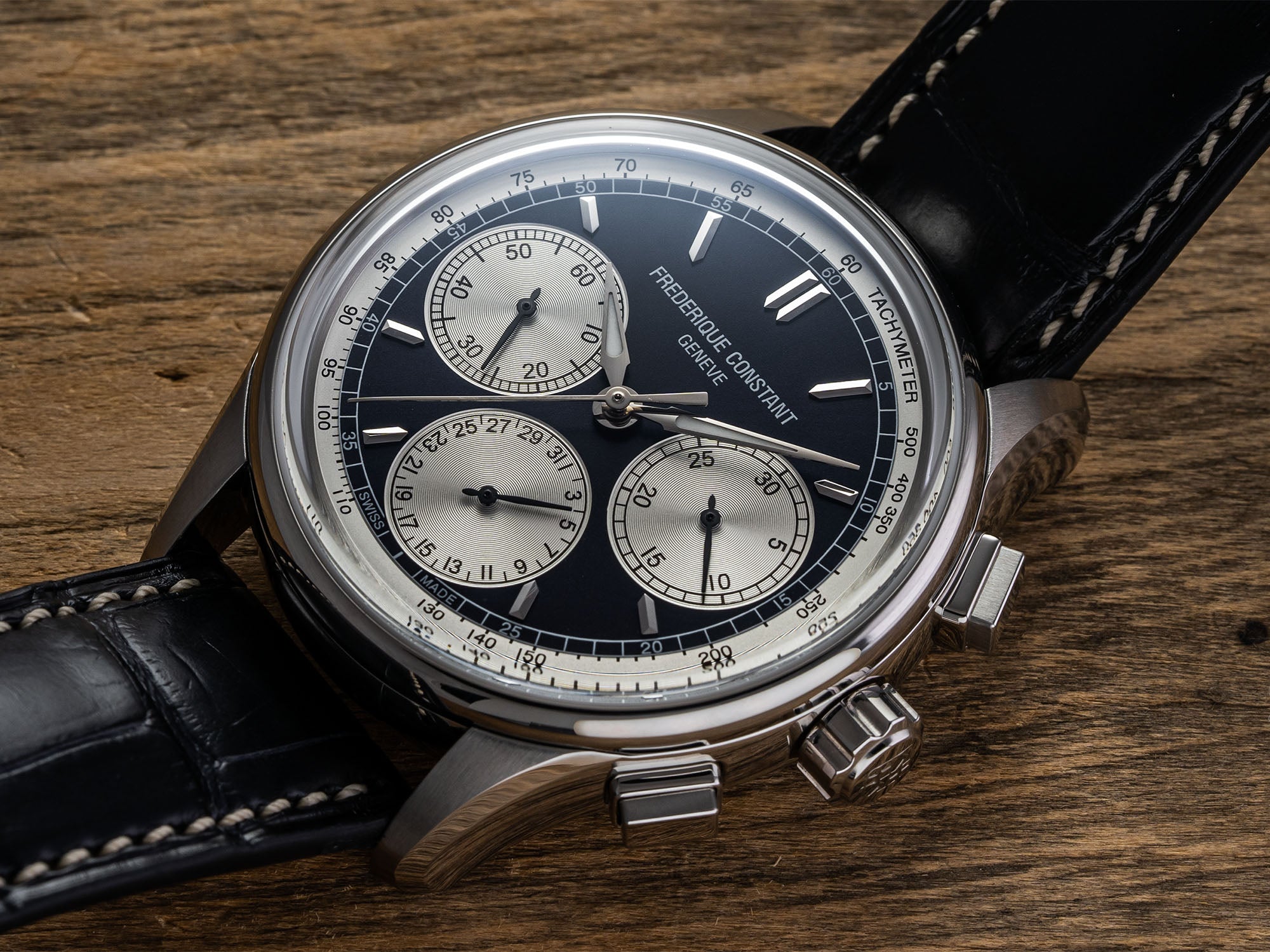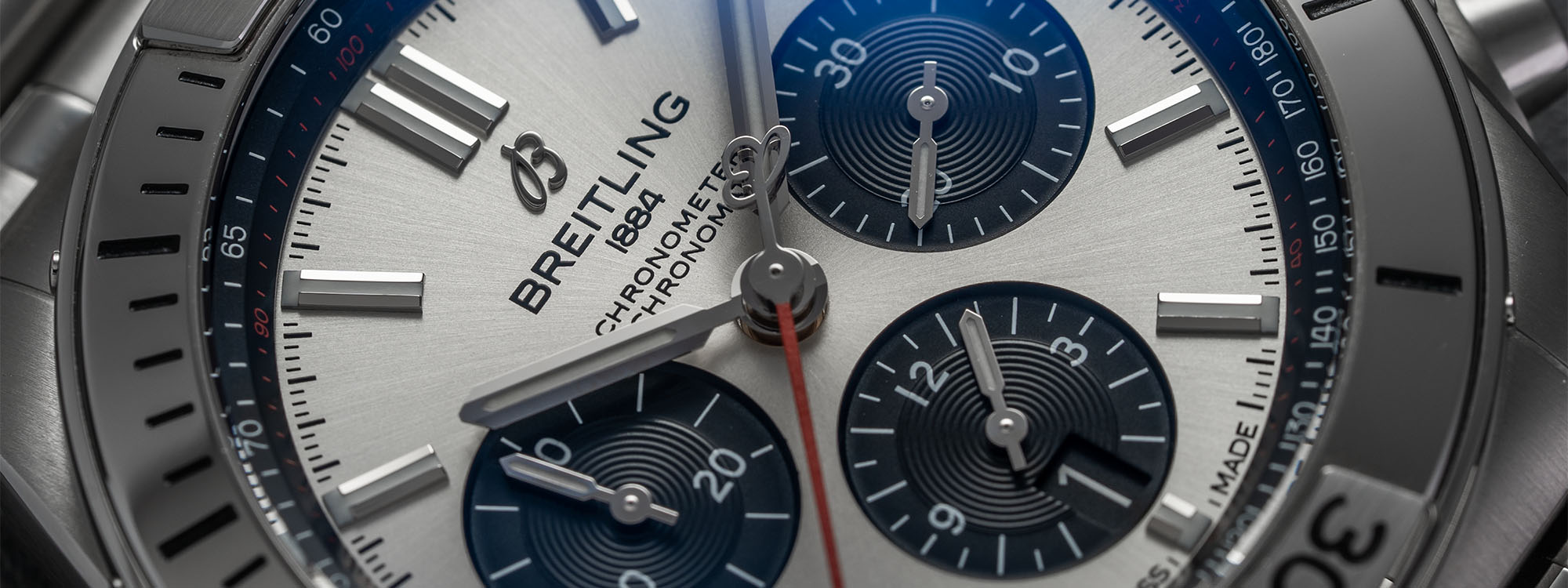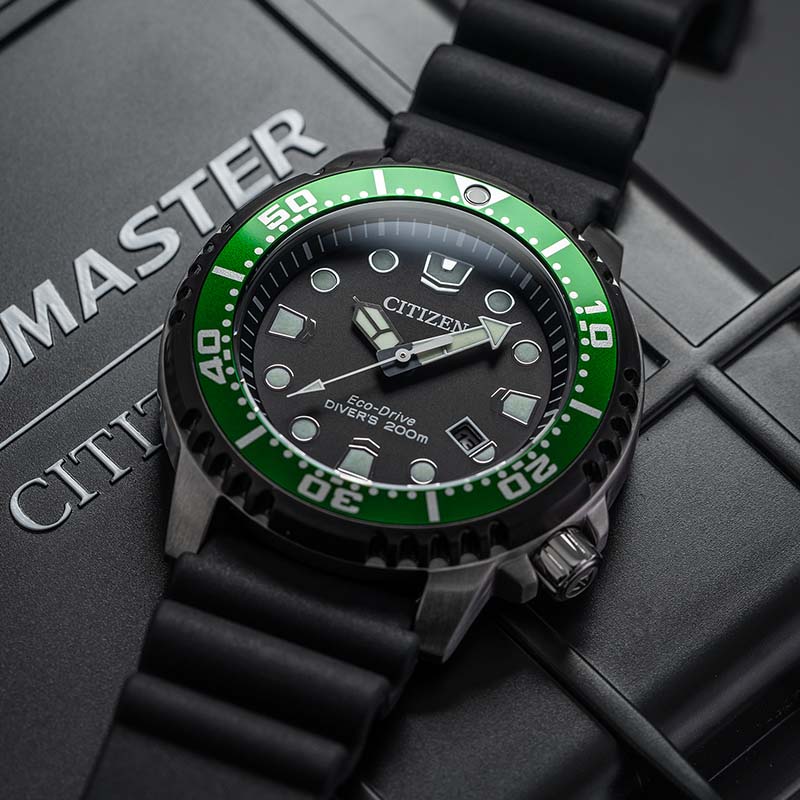A watch complication, by definition, is any function offered by a timepiece that is in addition to its primary function of keeping the time. Despite the name, watch complications don't really have to be, well, all that complicated: that date display you glance at before signing a check qualifies as a complication even though it's not nearly as complex and dynamic as, say, the split-seconds chronograph you use to time racing laps or the world-time function you consult before making a call home on an international business trip. Here we run down the major watch complications from the simplest to the most mechanically sophisticated, and provide an example of each.
Date Complications:
Date Window

Probably the most common of “small complications,” this is simply a display of the date via a numbered disk that passes under an aperture in the dial, usually positioned at 3 o’clock, 4:30, or 6 o’clock. Unless the watch is an annual or perpetual calendar, this date will need to be manually adjusted forward at the end of any month shorter than 31 days. Some watches, like the Rolex Submariner, enlarge this display by placing a magnifying lens over the window.
Large Date

This one also goes by “big date” “grande date,” or “panorama date,’ and is essentially just a larger version of the standard date display, though it usually uses two date disks (one for the tens numeral and the other for the ones) rather than one, and a double window, with each numeral appearing in its own framed aperture. High-end German brands like A. Lange & Söhne and Glashütte Original have become synonymous with this complication, though several Swiss luxury brands offer it as well.
Pointer Date

This type of date display uses a center-mounted hand that moves around the dial in daily increments to point to the current date on a numerical scale (1-31), usually on the periphery of the dial. Oris's Big Crown Pointer Date, a mainstay of that Swiss brand's collection since 1938, was one of the first watches to popularize the style.
Day/Date

In a day-date watch, the day of the week and the date numeral appear in separate windows, often but not always adjacent to each other. The Rolex Day-Date, for example, features the day in an aperture at 12 o’clock and the date in a window at 3 o’clock; the Junghans watch above places the date display at 6 o'clock.
Calendars:
Triple Calendar

Essentially one step up in complication from a day-date, a triple calendar displays the day, date and month in a specific arrangement of windows, subdials, and/or analog hands. It is the simplest type of calendar complication, requiring adjustment at the end of any month of a shorter duration than the default 31 days. The triple calendar might also include a moon-phase display and can be combined with other complications, like the Longines watch pictured above.
Annual Calendar
 Slightly more complex is the annual calendar, a complication first built into a wristwatch by Patek Philippe in 1996. As per its name, an annual calendar is designed to be manually adjusted by its wearer only once per year. Its movement compensates for the individual lengths of all the 30-day and 31-day months; only at the end of February, which has either 28 or 29 days depending on the leap year, does the watch’s owner need to move the date forward to the 1st of March. The Laurent Ferrier watch above opts for the analog-style "pointer" date display as described previously.
Slightly more complex is the annual calendar, a complication first built into a wristwatch by Patek Philippe in 1996. As per its name, an annual calendar is designed to be manually adjusted by its wearer only once per year. Its movement compensates for the individual lengths of all the 30-day and 31-day months; only at the end of February, which has either 28 or 29 days depending on the leap year, does the watch’s owner need to move the date forward to the 1st of March. The Laurent Ferrier watch above opts for the analog-style "pointer" date display as described previously.
Perpetual Calendar

The most sophisticated type of calendar watch, a perpetual calendar is endowed with a mechanical “memory” that enables it to display the time, day, date, month, and often the moon-phase, accurately for many years. The complex movement in a perpetual calendar compensates for the length of every month, including February in both leap years and non-leap-years, meaning that it should not need adjusting until the year 2100, which is the next annum in which the Gregorian calendar’s leap-year cycle is disrupted: it will be the first year since 1900 that is exactly divisible by 100 but not by 400, and thus not a leap year. In rare instances, as in the Patek Philippe reference pictured above, a perpetual calendar can be combined with other complications like a chronograph for an even higher level of horological savoir faire.
Chronographs:
Chronograph

One of the most popular complications is the chronograph, also called a stopwatch, which is a timepiece that can be used to measure elapsed times. Most modern chronographs use a center-mounted hand to count the elapsed seconds; subdials or “totalizers,” to tally the elapsed minutes and/or hours; and pushers or buttons on the side of the case to start, stop, and reset the chronograph hands. Originally, chronographs were equipped with a single pusher (“monopusher” or “monopoussoir” in French) to operate all the stopwatch functions, and some chronograph watches are still designed in this vintage style. Breitling invented the more common two-button chronograph design in 1923. Most chronograph dials are either bicompax (with two subdials) or tricompax (with three subdials, like the Bulova pictured above). Check out some of the most popular chronographs here.
Flyback Chronograph 
A chronograph with a flyback function (known in French as a “retour-en-vol”) enables the user to stop, return to zero, and instantly restart the elapsed-seconds hand to begin timing a new interval — distinguishing it from a standard chronograph in which stopping, returning to zero, and restarting each require a separate push. Because of the complexity of this mechanism, most flyback chronograph watches are on the pricey side, but Frederique Constant offers one for under $5,000 (above).
Split-Seconds Chronograph
 Often referred to by its French name, rattrapante (for “catch up”), a split-seconds chronograph is equipped with not one but two elapsed-seconds hands, one positioned directly above the other while the chronograph is switched off. Both hands are started and returned to zero simultaneously via a pusher. A second pusher allows the split-seconds or rattrapante hand, usually the one underneath, to repeatedly separate from the upper hand to record split times and then be instantly returned into its position under the other, still-moving hand (i.e., it “catches up”). A split-seconds chronograph (like the model above, from Vacheron Constantin's Excellence Platine collection) is particularly useful for timing a series of events in quick succession, like laps in a race.
Often referred to by its French name, rattrapante (for “catch up”), a split-seconds chronograph is equipped with not one but two elapsed-seconds hands, one positioned directly above the other while the chronograph is switched off. Both hands are started and returned to zero simultaneously via a pusher. A second pusher allows the split-seconds or rattrapante hand, usually the one underneath, to repeatedly separate from the upper hand to record split times and then be instantly returned into its position under the other, still-moving hand (i.e., it “catches up”). A split-seconds chronograph (like the model above, from Vacheron Constantin's Excellence Platine collection) is particularly useful for timing a series of events in quick succession, like laps in a race.
Chronograph scales:
Tachymeter

A tachymeter (or tachometer) is a numerical scale on a watch’s dial or bezel that is used in conjunction with the moving chronograph hand to measure an object’s speed over a predetermined distance. It is often used to determine miles or kilometers per hour and is thus a common feature of chronograph watches whose design is inspired by automobile racing. The Omega Speedmaster, which was the first watch to put this scale on the bezel rather than the dial of a chronograph, is among the most popular tachymeter watches, along with the Rolex Daytona. Jaeger-LeCoultre incorporated a tachymeter into its Polaris Chronograph (above).
Pulsimeter

A pulsimeter or pulsograph (as seen on the Montblanc watch above) is used to measure heart rates, and watches equipped with this type of scale are classically known as “doctor’s watches.” To record heart beats per minute, the user simply starts the chronograph timer, counts the number of beats before the hand gets to the number the scale is calibrated for (either 15 or 30), then stops the hand for the reading.
Telemeter
 Probably the rarest nowadays of all the scales on a chronograph, a telemeter is used to measure the wearer’s distance from an event based on the difference between visual and audible phenomena; in layman’s terms, the scale can be used with the chronograph seconds hand to determine how far away a thunderstorm is based on the amount of elapsed time between a flash of lightning and a crackle of thunder.
Probably the rarest nowadays of all the scales on a chronograph, a telemeter is used to measure the wearer’s distance from an event based on the difference between visual and audible phenomena; in layman’s terms, the scale can be used with the chronograph seconds hand to determine how far away a thunderstorm is based on the amount of elapsed time between a flash of lightning and a crackle of thunder.
Slide rule

Another Breitling invention, which debuted on the original Chronomat but is now a fixture of the Navitimer (above), a bidirectionally rotating slide rule bezel can be used in conjunction with the chronograph by pilots and navigators to make vital in-flight calculations. Based on the E6B slide rule that was commonly used in the days before electronic navigation, its concentric scales include standard mileage (STAT), kilometers (KM) and nautical miles (NAUT), allowing its user to determine factors such as fuel consumption, distance travelled, and climb and descent rates. Very few watches other than the Navitimer use a slide-rule bezel, and all of them are distinctly targeted at pilots and aviation enthusiasts.
Travel Complications:
GMT/Dual Time

GMT stands for Greenwich Mean Time, and a GMT watch is one that allows its wearer to read the time in (at least) two different time zones simultaneously. Most often, they do so with the use of a second hour hand and a 24-hour scale on the bezel or dial. A useful timepiece for frequent travelers, its main hour hand can be adjusted to point to the local time while the wearer is abroad, while the additional hour hand, usually designed to be distinct from the main one, points to the time at home, or “reference time,” on the 24-hour scale whose numerals correspond to the world’s time zones as established by the Greenwich Meridian. A GMT watch whose 24-hour bezel is rotatable can add a third time zone reading via the main hour hand. To discover some of our favorite GMT watches, click here.
World Timer

While a GMT watch allows for a view of two (in some cases three) time zones, a world time watch is designed to display the time in all 24 of the world’s time zones at once. Usually this style of watch combines a 24-hour scale that rotates around the dial, in concert with the hour hand, once a day, with an outer bezel inscribed with the names of 24 world cities, each representing one of the major time zones. The wearer can set this “city ring” to the local time while traveling and can read the time in any other time zone by seeing where the cities align along the 24-hour scale. We showcase some of our favorite world time watches here.
Moon-Phase

While not considered the most utilitarian complication for most, moon-phases add both beauty and a touch of science to a watch dial. Originally developed for early sailors to predict the tides, it replicates the waxing and waning of the moon, usually with a rotating disk with two small moons whose portions become visible as the disk moves behind a shaped aperture, displaying whether the moon is at its full, half, quarter, or new phase. Check out our list of noteworthy moon-phase watches here.
Power Reserve Indicator

As detailed in our Guide to Watch Movements, a watch’s power reserve is the amount of time, measured in hours or days, that it will continue to run before it needs rewinding. Some watches opt to display this reading on the dial, usually in an analog style with a hand moving along a scale from “full” to “empty” similarly to a fuel gauge, though some brands have found more unconventional ways to visually convey this information.
Mechanical Alarm

A very practical yet perplexingly rare complication is the mechanical alarm, which was first used widely in a wristwatch by Vulcain in the 1940s; its popular Cricket model (above) is still a flagship of the brand's product line today. The movement of such a watch is usually equipped with an independent hand connected to.a notched cam and operated by an additional crown, which can be set to activate a hammer that strikes a membrane for a vibrating buzz that reminds the wearer of an event. After being alerted by the sound and vibrations, the wearer can then switch the alarm off with a pusher. Jaeger-LeCoultre's Memovox and Tudor's Advisor are other well-known examples of mechanical alarms.
Tourbillon

Not really a complication by the strictest meaning of the term, as it doesn’t add an additional function to the timekeeping, a tourbillon is nevertheless held up as an example of elite horological technology and watches equipped with them are highly prized and almost invariably pricey. Patented by Abraham-Louis Breguet in 1801, the tourbillon (French for "whirlwind") was a device designed to compensate for the ill effects of gravitational pull on a watch movement's accuracy by placing the balance and escapement inside a rotating cage that made a 360º revolution every minute. While its gravity-defying functionality is less important in a relatively mobile wristwatch than in a mostly stationary pocket watch, the tourbillon's balletic motions make a luxury watch come to mesmerizing life when it is displayed through a dial aperture, as it is in the vast majority of timepieces that include it today, including the Breguet watch above.
Minute Repeater

One of the most expensive and coveted complications is also one of the most archaic and obsolete. A minute repeater, which chimes the time audibly on demand, was a fixture of pocket watches in the 18th and 19th Century and served as a practical method of alerting its wearer of the current time in the dark, in the era before electric lighting or luminous details on watch dials. Definitively regarded as more a luxury today than a tool, a minute repeater has an independent chiming mechanism with two small hammers striking coiled metal gongs, generally activated by a slide on the side of the case, to produce different tones for the hour, quarter hour, and minute. The most sophisticated of these chiming watches might also include a grande sonnerie, and/or petite sonnerie: the former perpetually strikes the hour every hour and the hour plus the quarter-hour at every quarter, without any need for the wearer to activate it with a slide; the latter strikes the hour every hour, and the quarter-hour (but not the hour) every quarter, also independently of any activation by the wearer. Sometimes the chiming functions are even coordinated with moving, elaborate dial animations called automata, like the Jaquet Droz Bird Repeater above.






















































4 Comments
You can also try Sylvi watches for their unique and stylish designs.
Really good article, but the Rolex Day-Date has the date display at 3, not 6, unlike what is stated in the article.
☝️🤓
Nerd